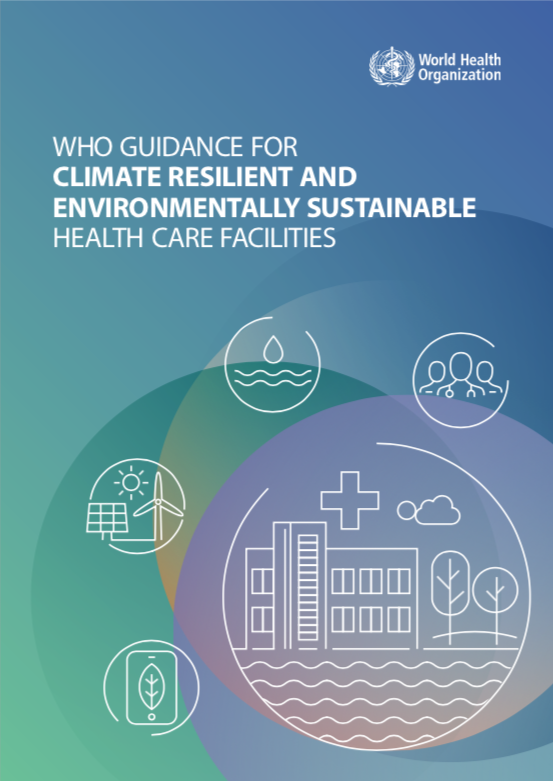Photo credit: Jakarta, Jan. 2. Dasril Roszandi / NurPhoto / Getty Images
The World Health Organization today releases its new ‘WHO Guidance for Climate Resilient and Environmentally
Sustainable Health Care Facilities’. Co-authored by Health Care Without Harm, an international NGO that works to transform health care worldwide so that it reduces its environmental footprint, becomes a community anchor for sustainability, and a leader in the global movement for environmental health and justice.This release coincides with the International Day for Disaster Risk Reduction (DRR) declared by the UN. For health care, this document comes at a crucial time when the sector is in the forefront of the worst impacts of the Covid-19 pandemic and increasing climate disasters. The pandemic amplifies the health risks for the general population and health workers during extreme weather events.
Some 7,348 major disaster events were recorded globally, claiming 1.23 million lives, affecting 4.2 billion people and causing $2.97 trillion in economic losses from 2000-2019. China (577) and the United States (467) recorded the highest number of disaster events, followed by India (321), the Philippines (304) and Indonesia (278). Eight of the top 10 countries are in Asia. The most vulnerable populations of Southeast Asia to climate events consist of small-scale and marginal farmers dependent on rain-fed agriculture, the rural poor, urban slum dwellers, mountain people, the populations of small islands and those living on the seacoast.
Extreme weather events can damage and destroy health facilities, and disrupt health services. Therefore, establishing climate resilient health infrastructure and services is essential. It is also important to strengthen the resilience of essential environmental services to health facilities, such as water, sanitation services and electricity supply that may be cut off during extreme weather events.
One of the seven global targets of The Sendai Framework for Disaster Risk Reduction is to “substantially reduce disaster damage to critical infrastructure and disruption of basic services, among them health and educational facilities, including through developing their resilience by 2030”.
In the Guidance, climate-resilient health care facilities are defined as those that are capable to anticipate, respond to, cope with, recover from and adapt to climate-related shocks and stress, so as to bring ongoing and sustained health care to their target populations, despite an unstable climate. Meanwhile, a “safe hospital” is a facility whose services remain accessible and functional at maximum capacity, with the same infrastructure, before, during, and immediately after the impact of emergencies and disasters.
Earthquake resilience mechanism seen at the Dalin Tzu Chi General Hospital in Taiwan
Building on the concept of risk as a function of hazards, vulnerabilities and exposures, the Guidance depicts how hazards, in the form of a sudden event (a shock, such as a storm or sudden flood), or a slow-onset event (a stress, such as a drought, sea-level rise, or high volume of cases from a climate-related disease), will reduce a health care facility’s level of performance and capacity through a combination of impacts on key facility elements (for example, increasing vulnerability of the health workforce or infrastructure), and increasing risks. The level of resilience will define whether the facility will recover its pre-event state, recover but to a state worse than before, or recover and attain a level of resilience greater than before the event.
Key interventions to build resilience in health care facilities include bolstering the health workforce (such as training, communications), optimizing access to food, water, sanitation and health care waste services through monitoring, assessment and management, improving access and reliability of energy sources (such as back-up systems, alternative sources of energy, emergency plans), as well as the adaptation of infrastructures and technologies (such as building retrofits, adoption of new systems and technologies, sustainability of operations).
The Guidance provides a list of interventions organized into 24 tables, divided under health workforce; water, sanitation and health care waste; energy; and infrastructure, technology and products. Examples of such interventions relating to DRR include: siting of new health care facilities to avoid high-risk areas prone to damage from hurricanes, windstorms, floods or water surges; laminating glass windows to prevent shattering during disasters; improving safety roofing to withstand wind velocities of 175–250 kph in high intensity tropical storm prone areas; and having plans in place for operating and maintaining critical systems in emergencies and disasters.
Health systems need to be increasingly fortified and continue to be efficient and responsive to improve health, reduce inequities and vulnerability, and provide adequate social and financial protection, in light of the shocks and stresses they may face from climate events. This requires a public health approach to protecting populations from climate change; health engagement in iterative, multi-sectoral adaptation; building climate-resilient health systems; and incorporating resilience into health governance and policy.
With this in mind, Health Care Without Harm’s ‘Health Care Climate Challenge’ which was launched back in 2015 at the Paris Climate Conference is built on three pillars: mitigation, resilience and leadership. Its resilience assessment focuses on factors such as a multi-hazard assessment; disaster resilience plans, and healthcare service delivery needs during and after extreme climate events. The Health Care Climate Challenge currently has over 300 participants, representing the interests of more than 22,000 hospitals and health centers in 34 countries. The HCCC is tied closely with HCWH’s Green and Healthy Hospitals Network which has ten sustainability goals ranging from energy to buildings. These goals will help build a hospital’s resilience from within.
With healthcare at the frontlines of the Covid-19 pandemic and worsening climate disasters, investment in resilient healthcare facilities and supporting services should be priority for all health agencies both in the private and public sectors. The safety of the people, especially those most vulnerable to disasters, depends on it.
References:
https://apps.who.int/iris/handle/10665/335909
https://www.gmanetwork.com/news/news/nation/759534/philippines-4th-hard…
https://www.who.int/docs/default-source/searo/wsh-och-searo/review-of-c…
Sendai Framework for Disaster Risk Reduction 2015–2030. Geneva: United Nations Office for Disaster Risk Reduction; 2015 (https://www.undrr.org/publication/sendai-framework-disaster-risk-reduct…
https://www.who.int/phe/climate/conference_briefing_1_healthresilience_…
http://healthcareclimatechallenge.org/
greenhospitals.org

